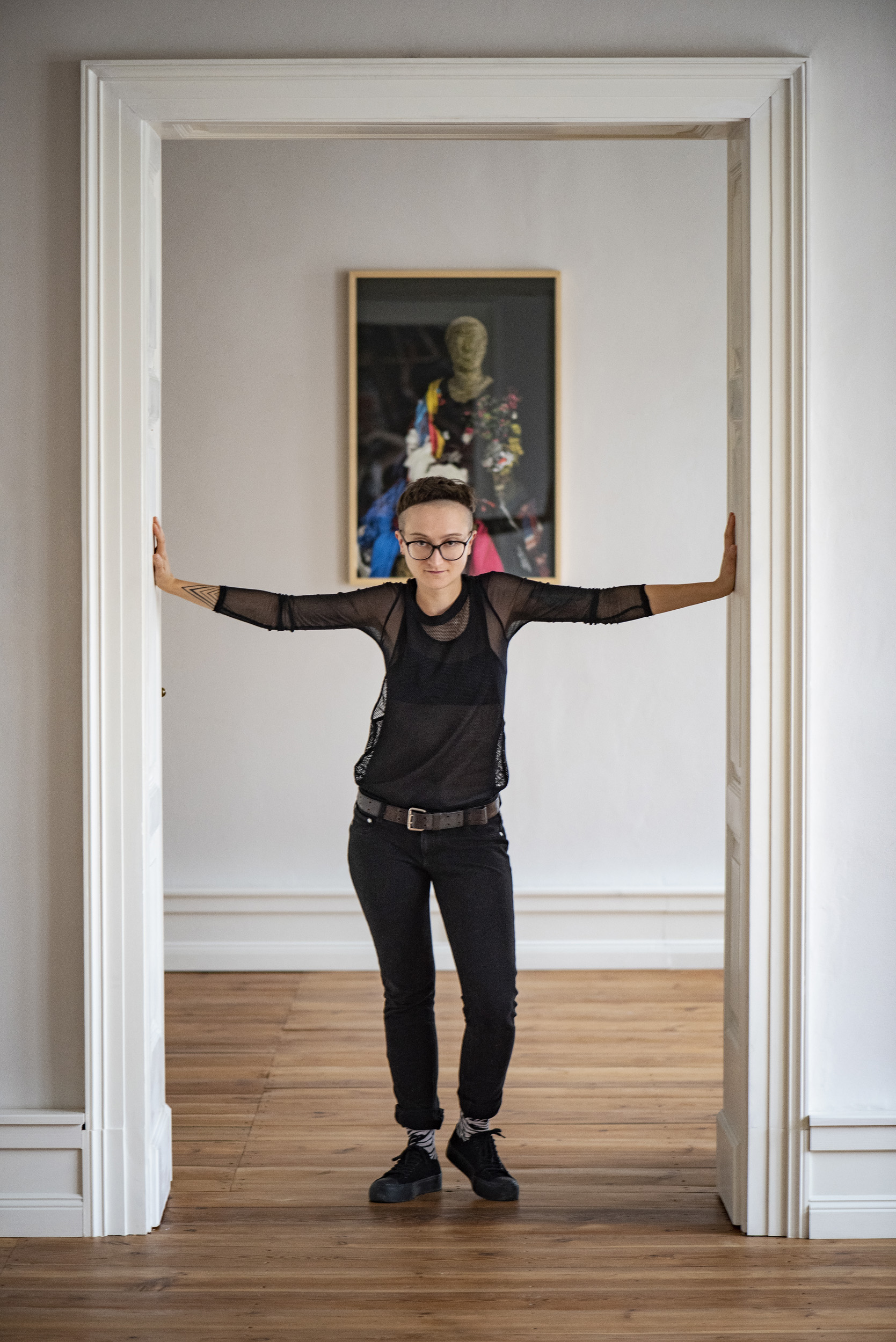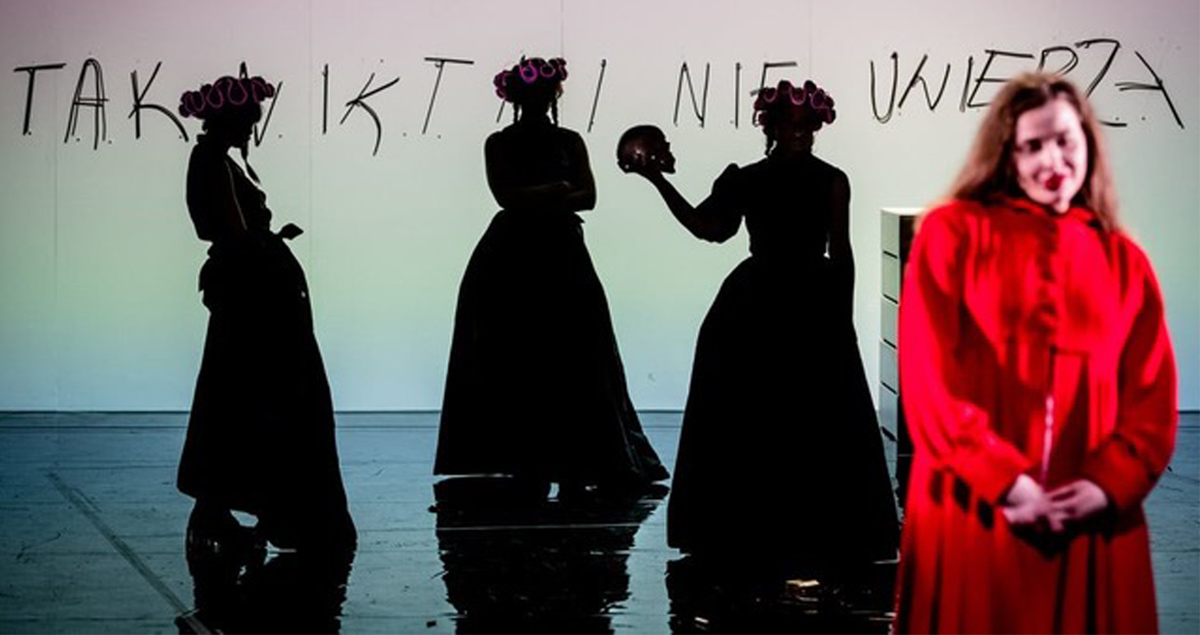Artist Liliana Zeic wants to inspire empathy, sensitivity and revolution
This is our PolandIn 2013, a screening by artist Liliana Zeic (formerly known as Liliana Piskorska) was stormed by a mob of masked men in balaclavas. Entitled “A Journey”, the film shows a same-sex couple travelling through Poland and recreating typical wedding photos along the way. Created together with fellow artist and activist, Martyna Tokarska, for two weeks Zeic and Tokarska hitchhiked across Poland with little luggage and two wedding gowns. They posed against classic Polish cityscapes, buildings, and historical monuments, sometimes kissing and holding hands, while the photographers documented the shock or amusement of those passing by. In one of the photos, the couple holds up a sword to the Wawel Dragon sculpture, a landmark in Kraków. The film juxtaposes this footage with recorded conversations with passers-by about LGBTQ+ rights.
The break-in in Toruń happened before the exhibition ever had a chance to open. Zeic says the incident didn’t scare just her: a single mum living above the artist-run gallery space first heard the group of men smash windows and threaten to burn down the place. For fear of any more violence, the owner of the building decided to cut ties with the artists. On that occasion, Psiskorska’s screening never went ahead; and it wasn’t the only time the artist faced a backlash and censorship. That same year, her exhibition in Elbląg, featuring “A Journey”, was taken down by the mayor of the city.
Zeic’s art is a fusion of activism and something she refers to as “radical sensitivity”. “I am a queer lesbian who grew up in the Polish countryside, raised by a family with a history of alcohol abuse. I use my personal encounters and events in the hope that they will be useful for other people. I try to bring in new perspectives, but I do this with attention and care.”
Besides photo and video, she experiments with an array of material including metal, straw, rope, animal fur and skin, drawings, and text; she’s also made body casts out of chalk, and staged public performances involving used clothing.
I first came across Zeic’s work through her MA graduation project Bitches. Self-portrait with a lover (2013), which is a piece comprising two dog-like sculptures. “This was my coming out as a lesbian, and coming out as an artist,” she tells me. “I created a chalk and paper cast modelled on my own body and my partner at the time. These were turned into two sculptures resembling dogs.” Zeic asked friends for their old animal furs, which older generations of Poles tend to store for harsh winters. She then used these fur scraps to cover the body moulds, which when pieced together evoke a sense of unease. Even when viewed digitally, it is not clear if the animal-skin sculptures are human, animal, or something else entirely.
She says she wanted to explore womanhood and animalistic desire, while hinting at luxury and death. Zeic uses the word “bitch” in the title to subversively detach it from its negative connotations. “The ethical context of this artwork was incredibly important for me. I started to notice numerous parallels between the way female bodies and animals are conditioned, in particular the fetishisation of the queer female body.”
Despite having obtained a PhD in Fine Art at one of Poland’s renowned art academies, Zeic feels that it was her active involvement with feminist and queer communities, rather than formal art education, which developed and pushed her work and helped her to become the artist that she is today. “I learnt the most by organising events and protests and by working with others as a collective unit. This experience also taught me how to critically examine academic hierarchies,” she explains. Zeic’s art has always been shaped by the causes close to her heart — namely, bringing attention to LGBTQ+ rights and the experiences of minority groups in Poland, as well as re-examining history and curriculum choices. In her view, “attending university wasn’t a ground-breaking experience, as a lot of the institutions where I studied were quite conservative.”
Despite the fact that most of her work stems from personal experiences, each project is laboriously researched. Last year she worked on a performance project dedicated to a Brazilian trans woman, Dina Alma de Paradeda, who committed suicide in 1906 in Wrocław, a city where Zeic currently lives and works. She started this project from a frustration about the way that LGBTQ+ voices are often written out of history. “One of the things that I like about Poland is the digitalisation of historical publications and their accessibility online, but I always encounter a lack of information related to stories about non-normative sexuality and non-normative gender.” For this work, Zeic combined archival imagery and historical records with traditional Polish legends and folklore to bring Dina’s story to the public and raise awareness about ongoing discrimination. Because Dina’s story is set in Wrocław, formerly the German city of Breslau, Zeic uses this as an opportunity to explore the Germanisation of Poland, which too is often left out of history books.
Her most recent project Sourcebook (2020) builds a non-normative history of women in Poland using photographs, objects, drawings, and text. Made up of of stories and protagonists marginalised from mainstream history, Zeic describes the project as an “archive of queer womanhood lesbianhood, for dykes, sapphics, and WLWs.”
“Sometimes, when I am planning a performance in a public space, I have to wait until the last moment to know for sure whether it will be able to go ahead,” she says about the numerous closures and obstacles she faces as an artist working with LGBTQ+ issues. “Obtaining authorisation for a performance [like the one on Dina Alma de Paradeda] is complicated and I’ve discovered that local town planning administrative bodies lack information on how to arrange such events,” she continues. As a result, she’s come to expect delays and interruptions.
“I focus more and more on queerness and queer identity, and I’ve noticed that it has become increasingly difficult to tackle such themes, as many institutions in Poland are scared to engage with them.” The 2013 incident in Toruń only strengthened Zeic’s determination to draw attention to the question of LGBTQ+ rights, and similar matters. Though the attack was devastating, she stresses that institutional and economic censorship causes long-term damage to artists in Poland. “What terrifies me most is that the number of spaces for creative collaboration grows smaller each and every year,” she says.
While some spaces have closed, others have seen their directors change. One of Poland’s most prestigious art centres, the Ujazdowski Castle Centre for Contemporary Art in Warsaw, recently replaced its former director, Malgorzata Ludwisiaki, with Piotr Bernatowicz. Since being appointed as the new director, Bernatowicz has been using public money to acquire homophobic art, and even invited Hungarica, a Hungarian band whose member is a neo-nazi supporter, for his inauguration (the event was eventually cancelled). In addition, Ujazdowski Castle Centre also hired Jerzy Kwaśniewski, the president of Ordo Iuris, as one of its lawyers. This organisation identifies itself as an “Institute for Legal Culture” and actively contributed to tightening the abortion ban in Poland.
Zeic’s artwork has made it into the Wrocław Contemporary Museum, which she describes as one of the last “tolerant” creative institutions in Poland. “I fear that next year we are going to see even fewer possibilities,” she says about the future of the country’s cultural sphere. She would like her work to be seen by a broader audience, not just art professionals. “I like to think that I tackle universal topics in my work, but locality, Eastern European and Polish identity are also incredibly important for me. What I want to inspire with my art is empathy, sensitivity, and revolution.”
__3.jpg)
__2.jpg)
__1.jpg)
__4.jpg)

_Liliana_Piskorska_Autoportret_z_pożyczonym_mężczyzną.jpg)
